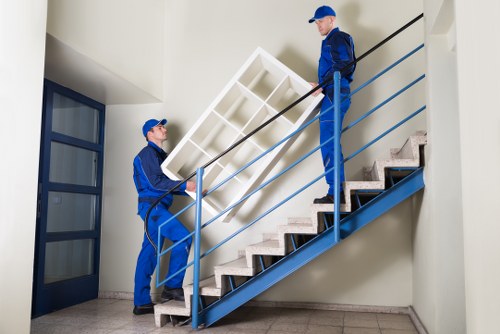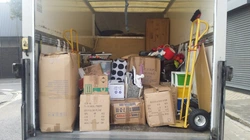Office Removals in Moving Van
Planning Your Office Move

Relocating your office can be a daunting task, but with the right office removals strategy, the process can be smooth and efficient. Proper planning is crucial to ensure minimal downtime and disruption to your business operations.
Start by assessing your moving needs. Determine the size of your office, the volume of equipment and furniture, and any specialized items that require special handling or transport. This initial assessment will help you choose the appropriate moving van and understand the resources you'll need for a successful move.
Next, establish a moving timeline. Create a detailed schedule that outlines each step of the process, from notifying stakeholders and updating your address to setting up utilities in the new location. A well-structured timeline will keep your team organized and on track throughout the entire relocation.
Choosing the Right Moving Van

Selecting the right moving van is essential for a hassle-free office relocation. Consider the size of the van relative to the volume of items you need to transport. A van that's too small may result in multiple trips, increasing costs and time, while an oversized van can be unnecessarily expensive.
Evaluate the van's features such as shelving, padding, and secure fastening options. These features ensure that your equipment and furniture remain safe during transit. Additionally, consider the fuel efficiency and reliability of the van to minimize operational costs and prevent delays due to mechanical issues.
Research different moving van providers to compare prices, services, and customer reviews. Opt for a reputable company with experience in office removals to guarantee professional handling of your belongings.
Preparing for the Move

Effective preparation is key to a successful office move. Begin by sorting and decluttering your office space. Identify items that are no longer needed and decide whether to sell, donate, or dispose of them. Reducing the volume of items to be moved can significantly lower costs and simplify the relocation process.
Develop a comprehensive packing strategy. Use high-quality packing materials to protect sensitive equipment and fragile items. Clearly label each box with its contents and the designated area in the new office to streamline the unpacking process.
Engage your team in the packing process. Assign specific tasks and ensure that everyone understands their responsibilities. Clear communication and collaboration will help prevent confusion and ensure that all items are accounted for during the move.
Loading the Moving Van

The loading phase is critical to ensuring that all your office items are transported safely. Start by loading heavy and bulky items first, placing them at the bottom of the van to maintain stability. Use furniture pads and straps to secure items and prevent shifting during transit.
Organize items systematically within the van. Group similar items together and leave accessible items near the front for easy access upon arrival. Proper organization not only protects your belongings but also makes the unloading process more efficient.
Double-check that all items are securely loaded before departure. Ensure that nothing is left behind and that all equipment is properly fastened to avoid damage or loss during the move.
Unloading and Setup

Upon reaching your new office location, the unloading process should be handled with care. Begin by placing items in their designated areas as indicated by the labels on each box. This organized approach saves time and reduces the likelihood of misplaced items.
Set up your office equipment and furniture systematically. Test all electronic devices to ensure they are functioning correctly. Pay special attention to installation procedures for complex equipment to prevent any operational issues.
Once everything is in place, conduct a final walkthrough to ensure that all items have been accounted for and that the new office space is organized and ready for business operations.
Tips for a Successful Office Removal

Here are some essential tips to ensure your office removal goes smoothly:
- Start Early: Begin planning your move well in advance to avoid last-minute stress.
- Communicate Clearly: Keep all stakeholders informed about the moving schedule and any changes.
- Label Everything: Clear labeling helps in the efficient unpacking and setup of your new office.
- Hire Professionals: Engage a reliable moving company experienced in office removals to handle the heavy lifting.
- Backup Important Data: Ensure all critical data is backed up to prevent any loss during the move.
Implementing these tips can significantly reduce the challenges associated with office relocations and help maintain business continuity throughout the process.
Remember, a well-executed move lays the foundation for a productive and organized work environment in your new office space.
Choosing a Professional Moving Service

Selecting the right moving service is paramount to the success of your office relocation. Look for companies with extensive experience in handling office moves, as they are more likely to understand the complexities involved.
Evaluate the services offered, such as packing, transportation, and unpacking. Some companies provide comprehensive packages that can save you time and effort by managing the entire relocation process.
Check for proper licensing and insurance coverage to protect your business assets during the move. A reputable moving service will offer transparent pricing and be willing to provide references or testimonials from previous clients.
Minimizing Downtime During the Move

Minimizing downtime is crucial to maintaining business operations during an office move. Plan the move during off-peak hours or weekends to reduce the impact on your daily activities.
Set up temporary workspaces if necessary to ensure that essential functions can continue without interruption. Communicate the move schedule to your clients and partners to manage expectations and maintain professional relationships.
Having a contingency plan in place can help address any unexpected issues that may arise during the move, ensuring that your business remains operational throughout the transition.
Ensuring the Safety of Office Equipment

Protecting your office equipment during the move is essential to prevent costly damages and downtime. Use appropriate packing materials such as bubble wrap, foam, and sturdy boxes to secure delicate items like computers, printers, and monitors.
Label all cables and accessories to make reassembly straightforward in the new office. Consider taking photos of your equipment setup before the move to reference during the unpacking and installation process.
For high-value or sensitive equipment, it may be beneficial to use specialized moving services that offer additional security and handling protocols, ensuring that your assets remain safe throughout the relocation.
Finalizing the Move

After unloading and setting up your new office space, it's time to finalize the move. Conduct a thorough inspection to ensure that all items have been delivered and are in good condition.
Update your business address with relevant entities, including clients, vendors, and regulatory bodies. Notify your IT department to set up network configurations and ensure that all systems are operational.
Celebrate the successful move by organizing a small office gathering to boost team morale and acknowledge everyone's hard work throughout the relocation process.
Frequently Asked Questions

How far in advance should I plan my office move?
It's advisable to start planning your office move at least three months in advance. This timeline allows for thorough organization, securing a reliable moving service, and addressing any potential challenges that may arise.
What items should I avoid moving to the new office?
Consider leaving behind outdated or non-essential items that no longer serve your business needs. This reduces clutter and ensures that only necessary items are moved, saving time and resources.
How can I ensure the safety of sensitive documents during the move?
Securely pack sensitive documents in fireproof and waterproof containers. Limit access to these containers during the move and inform your moving team about the importance of handling them with care.
Should I hire professional movers or handle the move in-house?
While handling the move in-house can save costs, hiring professional movers experienced in office removals ensures efficient and safe transportation of your belongings. Professionals are trained to handle delicate items and can help mitigate potential risks.
What should I do if some items get damaged during the move?
Immediately document the damage with photos and notify your moving company. Review your insurance policy to determine coverage and file a claim promptly to seek compensation for the damaged items.
For more information or to schedule your office removal, contact us today!
Conclusion
Office removals within a moving van require meticulous planning, the right resources, and professional expertise to ensure a seamless transition. By following the strategies outlined above, you can minimize disruptions, protect your valuable assets, and establish a productive work environment in your new location.
Whether you're relocating to a larger space, downsizing, or moving to a different city, partnering with a reliable moving service can make all the difference. Don't let the stress of moving hinder your business growth—book your service now and embark on your new journey with confidence.


